Physical Address
304 North Cardinal St.
Dorchester Center, MA 02124
The epidermis, the most superficial layer of skin, consists of keratinizing stratified squamous epithelium. The predominant cell type is the keratinocyte, making up 80% of the cells. Layers of the epidermis include the basal cell, prickle cell, granular cell, and keratin layers, with the overall thickness varying from 0.075 to 0.15 mm. The epidermis is thin at birth, becomes thicker during early adulthood, and thins during the fifth and sixth decades of life.
The epidermis is attached to the dermis by a basement membrane zone that extends from the epidermis to pilosebaceous units and sweat ducts located in the dermis. Each pilosebaceous unit contains sebaceous glands, a hair shaft and follicle with associated arrector pili muscle, and a sensory end organ. Epithelialization of partial-thickness skin wounds occurs from wound edges and the basement membrane zone around the hair follicles, sebaceous glands, and sweat ducts.
The dermis consists of a fibrous connective-tissue matrix made up of collagen, elastic tissue, and ground substance. Dispersed throughout the dermis are epidermal appendages, blood vessels, nerves, and cells. The most common cell in the dermis is the fibroblast. Fibroblasts have a synthesis role in wound healing, producing collagen, elastin, and ground substance. Fibroblasts behave as contractile cells during wound maturation.
The dermis is divided into a thin papillary and a thicker reticular dermis. The overall thickness of the dermis is variable, depending on its location. Eyelid skin has the thinnest dermis, measuring less than 1 mm thick. Dermal thickness measures 1.5 mm on the temple, 2.5 mm on the scalp, and greater than 4 mm on the back. The dermis is thin at birth, increases in thickness until the fourth or fifth decade, and then decreases with further aging. On average, men have thicker dermis than women.
Cutaneous blood flow is directed toward the more metabolically active epidermis through dermal papillae, hair papillae, and adnexal structures. Two vascular plexuses connected by communicating vessels are present in the reticular dermis. A deep plexus lies at the junction of dermis and fat; the superficial plexus gives rise to a rich capillary loop system in the superficial dermal papillae. This system provides nutrients to the epidermis through diffusion.
Occasionally, superficial facial defects are best addressed by repair with a skin or composite graft. Very young patients with tight facial skin presenting with large cutaneous defects are appropriate candidates for reconstruction using a full-thickness skin graft. Use of a skin graft is usually reserved for those cases that cannot reasonably be reconstructed with a local flap because of the size of the defect. The skin graft obviates the need for additional scars on the face or the use of a distant or microsurgical flap. Unfortunately, full-thickness skin grafts used in such cases frequently have a “patch” appearance with discrepancies of color and texture between native and grafted skin ( Fig. 15.1 ). Color and textured discrepancies between facial skin and skin grafts may also be problematic in elderly patients ( Fig. 15.2 ). Because of the tendency for elderly patients to have thin skin, however, grafts used to repair facial defects are more likely to display a better color and textural match with native facial skin than when similar grafts are used in younger patients ( Fig. 15.3 ). Postoperative dermabrasion assists in minimizing color and texture discrepancies between skin grafts and facial skin.
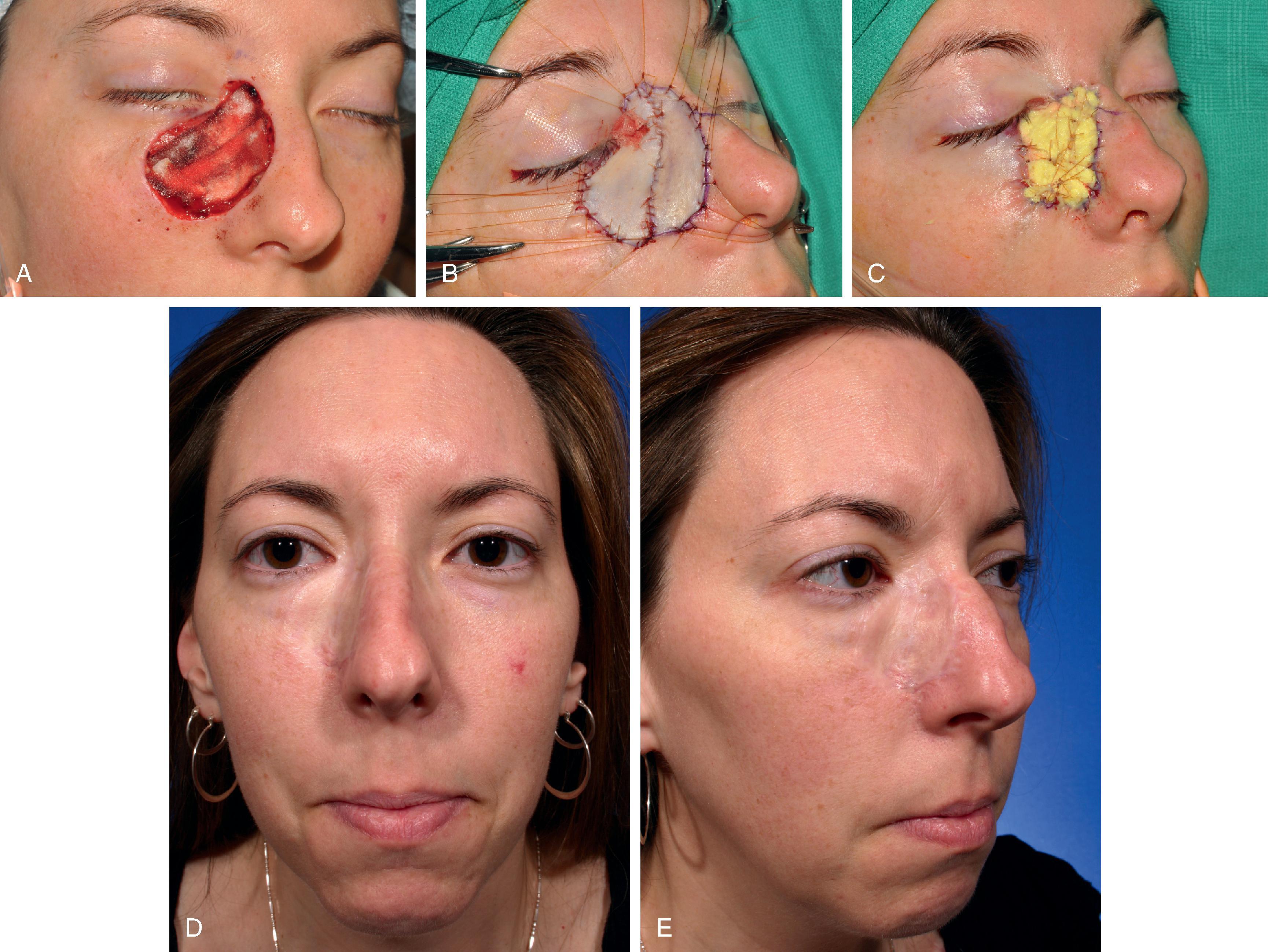
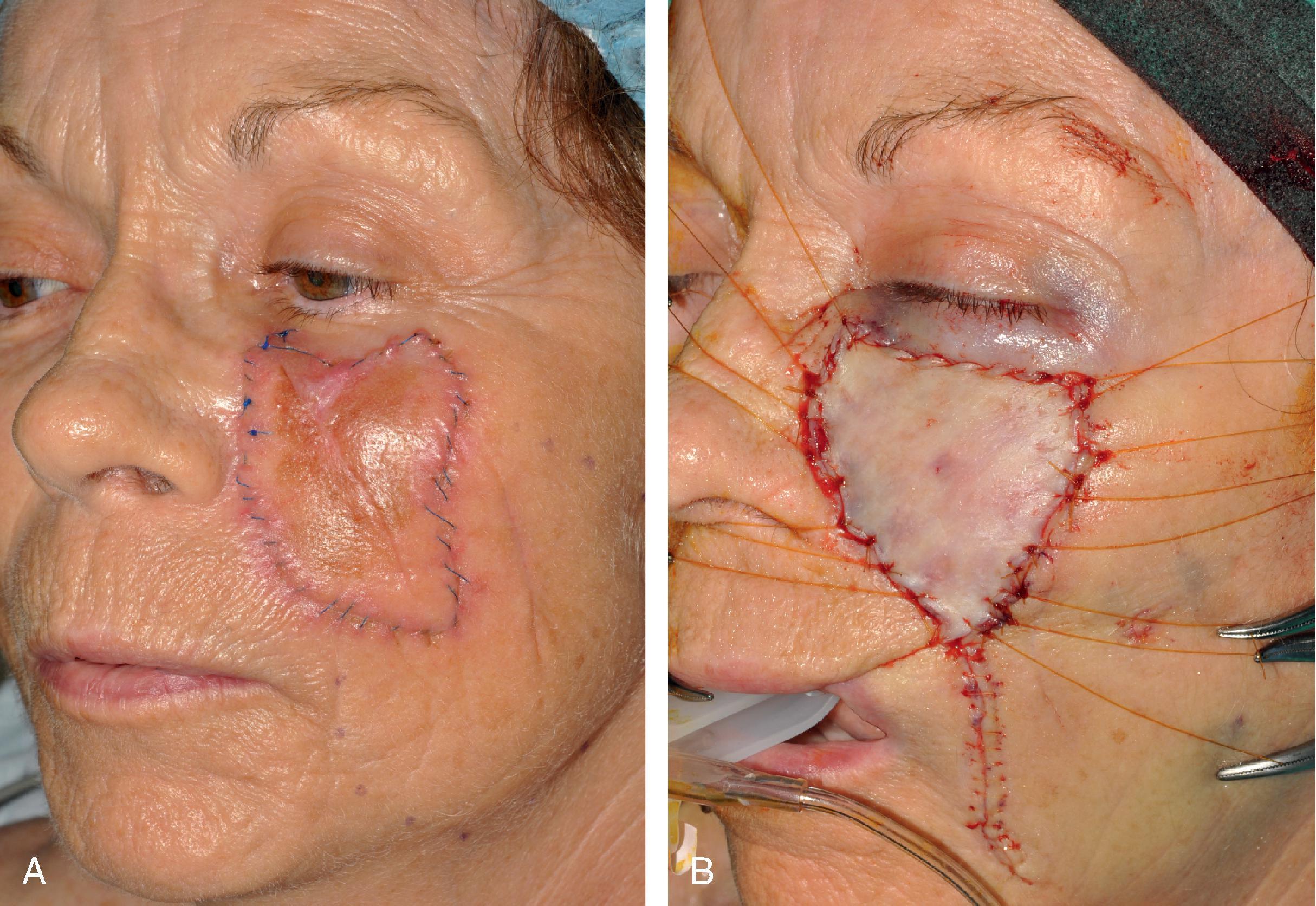
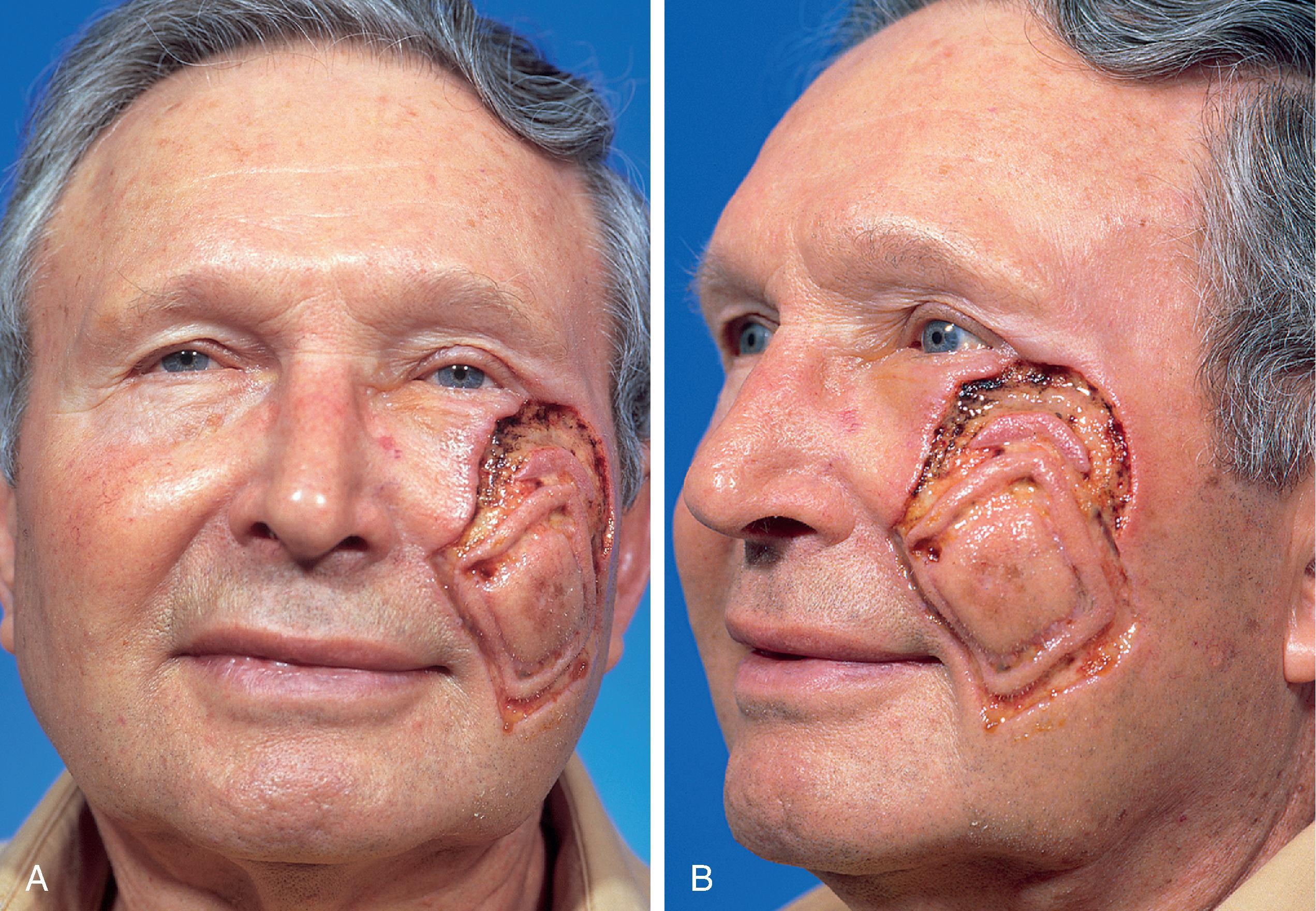
Skin grafting involves the removal of skin from one location and placement at a separate site. Skin grafts can be harvested in several different forms, including full-thickness, split-thickness, and composite grafts. Regardless of the type of skin graft, graft viability depends on several factors: vascularity of the recipient site, microcirculation on the surface of the recipient site, vascularity of donor graft tissue, contact between graft and recipient site, and whether the patient suffers from certain systemic illnesses.
Contact between the skin graft and recipient site is essential. A bolster dressing is helpful to prevent fluid collections beneath the graft postoperatively ( Fig. 15.4 ). Bolsters also prevent shearing forces from disrupting vascular connections between graft and wound bed. Systemic illnesses that may compromise graft survival include collagen vascular diseases, hematologic disorders, diabetes, nutritional deficiencies, and hypoxemia. Use of tobacco products is also detrimental to the survival of skin grafts.
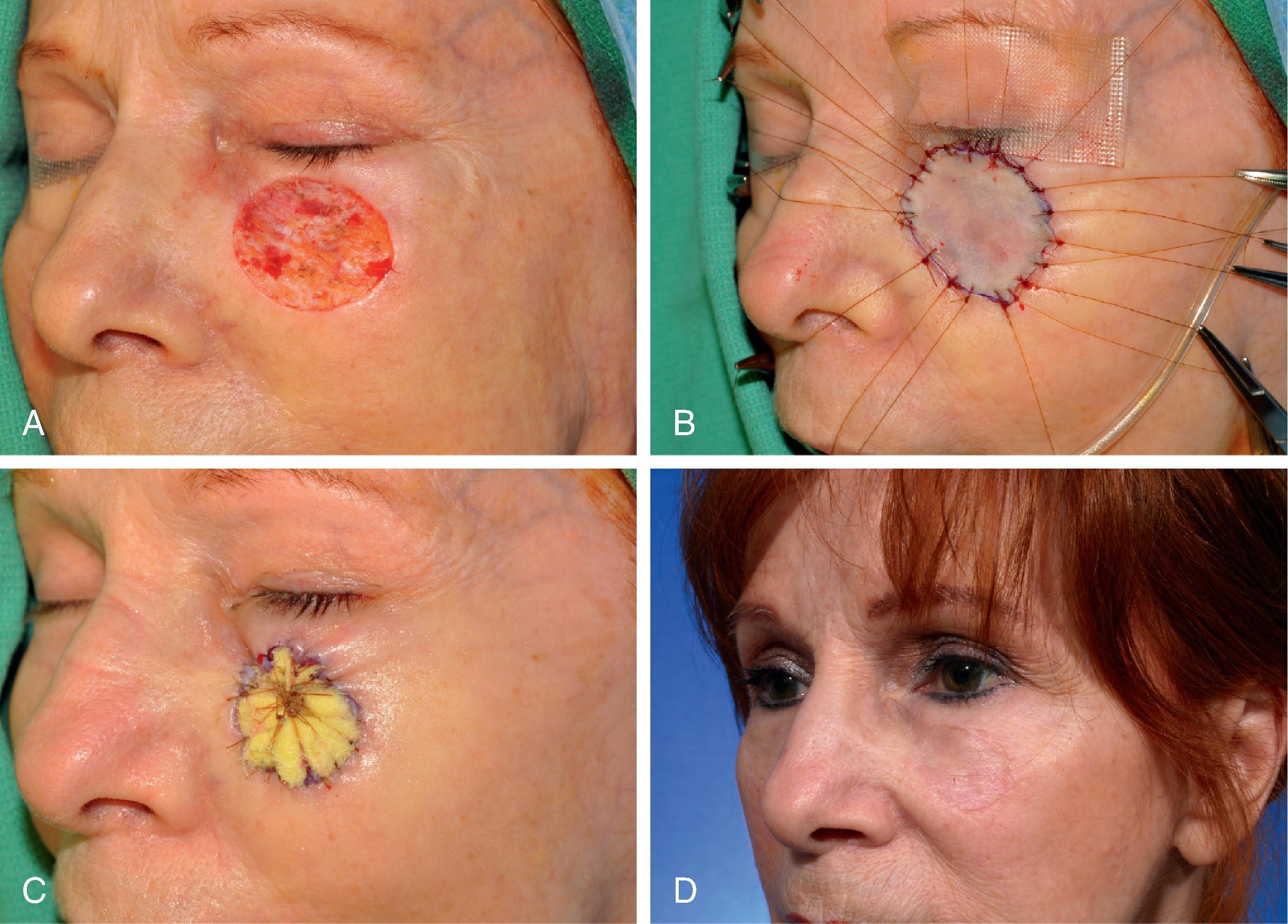
Recipient site conditions that are not favorable to skin graft survival include irradiated tissue, scar, exposed bone, cartilage, tendon, or a bleeding wound. Grafts placed over avascular defects smaller than 1 cm 2 may survive through nutritional support via wound edges; however, grafting over larger avascular wounds is unlikely to succeed. Skin graft survival on bone is enhanced if a thin layer of bone is removed with a diamond fraise burr until punctuate bleeding is achieved. On the skull, holes can be made in the outer bone table to allow communication with the inner diploe. Large areas of exposed bone, cartilage or tendon may require coverage with a muscle or fascial flap before grafting. Another technique that has proven successful in skin grafting auricular cartilage devoid of perichondrium is to create windows through the cartilage exposing perichondrium and subcutaneous tissue on the opposing surface of the ear. The windows are made as large as possible through the cartilage in areas that can be resected without jeopardizing the structural integrity of the ear. The windows provide a port for vascular ingrowth to revascularize the graft ( Fig. 15.5 ). Only very thin full-thickness skin grafts should be used for covering auricular cartilage so that the graft will not obscure the complex and delicate topography of the cartilage. Thin skin grafts are more likely to survive compared with thick full-thickness skin grafts given the limited contact with a vascular source for nourishment.
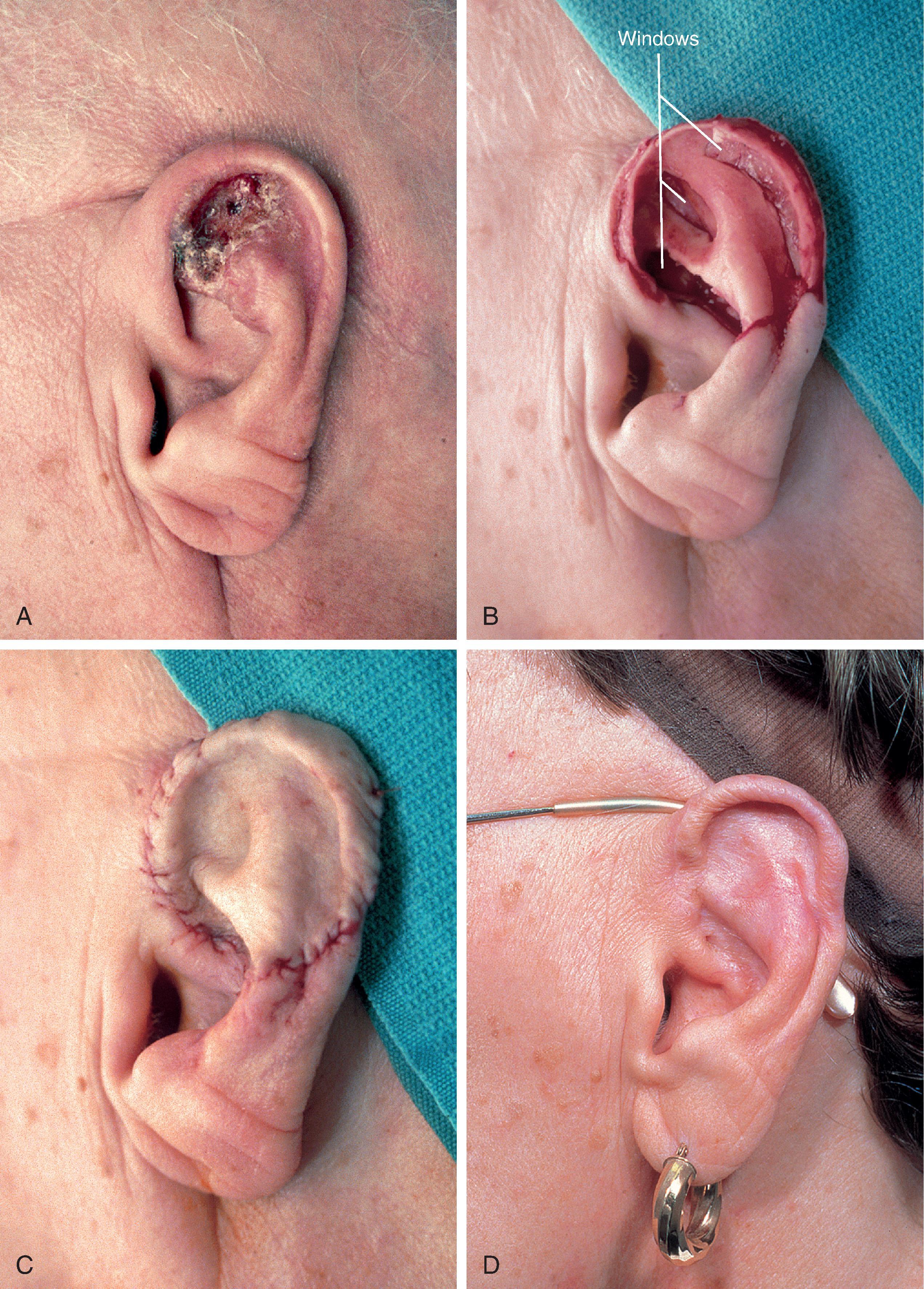
For deeper wounds, skin grafting may be delayed until granulation tissue has filled the wound bed (2–3 weeks). Any epithelium on the surface of the granulation tissue is removed before grafting, and the tissue is crosshatched so that myofibrils are released. Granulating wounds normally contain bacteria. Bacterial counts greater than 10 5 organisms per gram of tissue often lead to graft loss. When delayed grafting is planned, the patient is started on a 10-day course of an antistaphylococcal antibiotic 3 days before skin grafting. When necessary, wound cultures are obtained to direct antibiotic selection.
Facial defects occasionally involve multiple facial aesthetic regions. When considering reconstructive options, it is helpful to mark the division between different regions so that defects involving multiple regions can be repaired with separate methods. Following this principle enables the placement of scars along boundary lines. This in turn helps to preserve the natural contours of the face.
The aesthetic facial regions and their individual aesthetic units are based on variations in skin thickness and texture, as well as variations in contour created by the underlying facial framework. Optimal repair of a defect may require repositioning of skin and soft tissue within an involved aesthetic unit, thereby allowing eventual scars to lie within zones of transition between adjacent units. In addition, small defects may be enlarged to facilitate resurfacing of an entire aesthetic unit using a single repair method.
Establishing uniform wound depths and maintaining symmetry with contralateral facial regions are equally important. Before skin grafting, beveled tissue at the periphery of defects created by micrographic surgery is freshened, but the bevel is maintained to provide a gradual contour transition between the skin graft and adjacent facial skin. Additional techniques helpful in optimizing repair include angulation of curvilinear shaped defects, because round defects are more likely to undergo concentric scar contraction and result in trap-door deformity. Modifying the periphery of the defect by creating more acute angles often reduces the risk for this deformity.
Become a Clinical Tree membership for Full access and enjoy Unlimited articles
If you are a member. Log in here